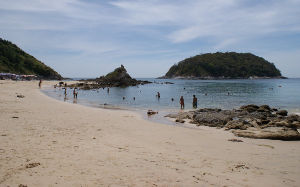Climate and Weather
The seasons in Thailand can be described as hot, hotter, and hot and wet.
In Thailand, they do not have four seasons. In the south, they only have two seasons, and in the north, they have three. No matter the number of seasons, it is hot all year, and part of the year it is wet as well.
Two Climates
Thailand has two different climates. In the south and southeast, including popular holiday destinations such as Phuket, Pattaya, Hua Hin, Koh Chang and Samui, there is tropical monsoon climate. In Central and North Thailand, including places like Bangkok and Chiang Mai, there is a tropical savannah climate.
Roughly speaking, you can draw a horizontal line just south of Bangkok; north of the line, there is tropical savannah climate with three seasons, south of the line, there is tropical monsoon climate with two seasons. The difference between the two climates is primarily that the tropical monsoon climate has a uniform temperature year-round, while the tropical savannah climate has greater temperature fluctuation.
Let's look at the difference between Phuket and Chiang Mai as an example. In Phuket, there is only a 2-3 degrees difference between the average temperatures all year round. In Chiang Mai in the north, the daytime temperature fluctuates around 6°C (11°F) during the year, while the night temperature fluctuates 9°C (16°F) degrees. Here, you will typically see the locals wearing outerwear in the evening when the temperature can fall to between 10°C (50°F) and 15°C (59°F) degrees.
Be aware that in mountainous areas, the temperature may fall even more; even below the freezing point at night. If you go trekking in January in northern Thailand, and you spend the night on the trail, short pants and a T-shirt will not do.
The Seasons
There are three seasons in the north. From November to February, it is dry and hot. From February to May, it is dry and even warmer, and from May to the end of October, it is hot and wet, also known as the rainy season.
In the south, there are two seasons; hot and dry, and hot and wet in the rainy season. Furthermore, in the south, the rainy season is different on the west coast facing the Andaman Sea, and on the east coast facing The Gulf of Thailand.
The monsoon is more intense on the west coast as it hits the coast directly from the sea; here, the rainy season is from May to the end of October. This area includes Phuket, Koh Lanta, Krabi, and Khao Lak.
On the east coast, the monsoon is weaker as it passes over land before reaching the coast. Here, the rainy season is from May and it may last until the end of November – and perhaps even into December in some areas, most notable in Samui. The rain can be extremely heavy here because the hot water provides energy and moisture while the air is cooling.
Rainy Season
Both tropical monsoon climates and tropical savannah climates have a rainy season. The rainy season in Thailand typically lasts from the beginning of May to the end of October.
Typically, September gets the most rain; however, the amount of rain can vary a great deal. The worst places can get upwards 600 mm (23 inches) rain, while other places get below 100 mm (4 inches). Furthermore, there are variations as to which month is the worst.
In the examples below, I have used July in case you want to visit Thailand in the summertime of the northern hemisphere, and September because it in most places is the worst month.
| September | Mm | Inches |
|---|---|---|
| Phuket | 361 | 14.22 |
| Samui | 122 | 4.79 |
| Bangkok | 334 | 13.16 |
| Pattaya | 205 | 8.06 |
| Hua Hin | 120 | 4.74 |
| Chiang Mai | 228 | 8.98 |
| Juli | Mm | Inches |
|---|---|---|
| Phuket | 258 | 10.17 |
| Samui | 116 | 4.58 |
| Bangkok | 175 | 6.89 |
| Pattaya | 97 | 3.84 |
| Hua Hin | 93 | 3.66 |
| Chiang Mai | 161 | 6.34 |
Some exceptions where September is not the worst month:
The worst month in Samui is November with a little more than 500 mm (20 inches), while the worst month in Hua Hin is October with just under 250 mm (10 inches).
If you plan to visit Thailand in the summertime of the northern hemisphere, you are better off visiting Samui than Phuket; at least regarding the weather. On the other hand, if you plan to visit Thailand in November or December, Phuket will be the better choice.
The amount of rain in the rainy season may seem terrifying; however, it isn't as bad as it seems. Most of the precipitation fall as torrential showers, lasting only a short time. In addition, when it rains, it pours; meaning that if the rain lasts several hours, a fair bit of the month's rain will fall in that time. Furthermore, most of the rain falls in the evening or at night.
That said, you do risk rain that lasts for several days with no hope of seeing the sun; if you want to minimize the chance of rain, you should visit Thailand in the high season from December to February.
If you want to go to Thailand at other times, you should check the climate for the places you want to visit. You can find information for various cities and areas at World Weather and Climate Information.
Weather Forecasts
Do not put too much into the weather forecasts. In high season, most of the rain falls as showers, typically lasting only 10-30 minutes and then the sun is back.
When you see a 7-day weather forecast, you will often see symbols for showers every day. However, you may not see as much as one drop of rain the whole week. Showers are difficult to foretell, both whether they fall and where they fall; thus, the forecasts have showers every day just to be on the safe side.

Fun Facts and not so Fun Facts
Bangkok is the world's hottest capital, even though several other capitals are closer to the equator. Even if we stick to the same area of the globe, Malaysia's capital, Kuala Lumpur, is closer, while Singapore is almost directly on the equator. According to Wikipedia, the annual average temperature in Bangkok is 29.13°C (84.43°F), in Kuala Lumpur, it is 28.2°C (82.44°F), while in Singapore it is "only" 26.98°C (78.8°F).
There are a large number of capitals in the Middle East and in Africa, where it gets a lot hotter in the summer than in Bangkok; however, it also gets colder in the winter; thus, the average temperature for the year is lower.
In Chiang Mai, they have an extra season, the smoky season. Typically, it lasts from February until the middle of May, and it diminishes the pleasure of staying in Chiang Mai quite a bit. Farmers burning fields and forests around Chiang Mai plus pollution from traffic, lack of rain and mountains to hold it all together, results in a thick duvet of smog over the city. The smog can be very uncomfortable and force visitors to spend most of the time indoors. Presumably, you do not go to Thailand to stay indoors.










